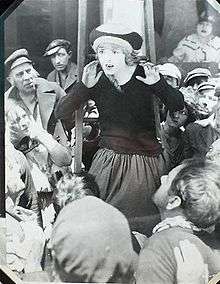Twinkletoes
| Twinkletoes | |
|---|---|
 | |
| Directed by | Charles Brabin |
| Produced by | John McCormick |
| Written by |
Winifred Dunn (scenario) Mervyn LeRoy (Comedy const) (screenplay) |
| Starring |
Colleen Moore Kenneth Harlan Tully Marshall Gladys Brockwell |
| Cinematography | James Van Trees |
Production company | |
| Distributed by | First National |
Release dates |
|
| Country | United States |
| Language |
Silent film English intertitles |
Twinkletoes is a 1926 silent film romantic drama directed by Charles Brabin and starring Colleen Moore. The film, as with most of Moore's vehicles at this time, was produced by her husband John McCormick with the couple distributing through Moore's resident studio First National. This film is one of Moore's surviving films from the late silent era and is available on DVD.[1]
Cast
- Colleen Moore – Twinkletoes
- Kenneth Harlan – Chuck Lightfoot
- Tully Marshall – Dad Minasi
- Gladys Brockwell – Cissie Lightfoot
- Lucien Littlefield – Hank
- Warner Oland – Roseleaf
- John Kolb – Bill Carsides (aka John Philip Kolb)
- Julanne Johnston – Lilac
- William McDonald – Police Inspector Territon
- Dorothy Vernon – ?
- Ned Sparks – ?
- Dick Sutherland – ?
- Carl Stockdale – ?
- Aggie Herring – ?
- Harold Lockwood, Jr. – ? (*son of the silent star who died in 1918)
Background
This was Colleen's first "serious" film since her portrayal of Salena Peake in So Big. It came between comedies, as it was the studio's strategy to stagger her comedies and dramatic roles, so that the public would not become tired of any single genre.
Story
Monica "Twinkletoes" Minasi, a motherless child of the London Limehouse district, is a brilliant young dancer who lives in poverty. She saves a crowd from abuse by the police through an impromptu performance, during which she meets Chuck Lightfoot, a champion fighter and older married man whose wife, Cissie, was the cause of the ruckus. Twinks finds herself slowly falling in love with Chuck but resists, because he is married and much older (he is in his late twenties, she might be as young as 15), but when he saves her from an attack one night she realizes that it is useless to fight her feelings.
She dances at the head of the "Quayside Kids," a local dance group in a music hall run by Roseleaf, who has designs on the young girls that dance for him. Chuck's wife Cissie realizes that her husband had feelings for Twinks and, learning that Twink's dad is a burglar, exposes him to the police. Twinks is distraught when she learns the news that her father—whom she admired above all other people—is a criminal. Roseleaf takes her to his apartment and attempts to have his way with her, but she manages to escape. Cissie is killed in an accident, and, in despair, Twink throws herself into the river. She is rescued by Chuck and in his arms finds something to live for.
Details
The movie was based on the book Twinkletoes: A Tale of the Limehouse,[2] by Thomas Burke. Like the book, the film's original story had a dramatic ending, with Twinks drowning in the river. Colleen's husband did not believe that the original ending would play as well as a happy ending, perhaps worried that the production might not be well received by audiences, as had been the case with the dramatic So Big. Two endings were filmed and exhibitors were allowed to pick which version they wanted to show.[3] The audiences generally preferred the sad ending.
Winifred Dunn did research in San Francisco's Chinatown for the atmosphere of the film[4] Coleen danced several of the numbers in the movie herself.[5]
References
- ↑ Twinkletoes at silentera.com database
- ↑ Twinkletoes: A Tale of the Limehouse
- ↑ Twinkletoes Production Box #2294, Warner Bros. Archives, School of Cinema-Television, University of Southern California.
- ↑ “Studies Chinatown in San Francisco,” Los Angeles Times, January 10th, 1926, page C14.
- ↑ Post Standard (Syracuse, New York), August 15th, 1926, page 4
Footnotes
- Jeff Codori (2012), Colleen Moore; A Biography of the Silent Film Star, McFarland Publishing,(Print ISBN 978-0-7864-4969-9, EBook ISBN 978-0-7864-8899-5).
External links
- Twinkletoes at IMDb.com
- Twinkletoes; allmovie.com
- lantern slide plate, coming attractions "Twinkletoes"